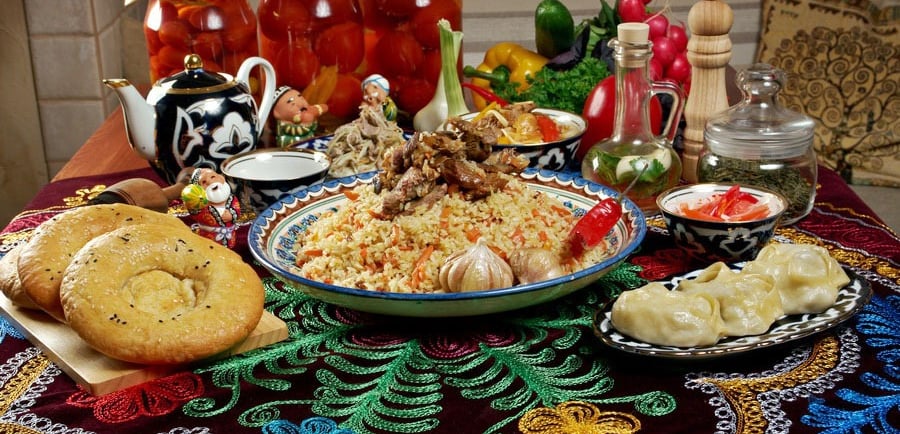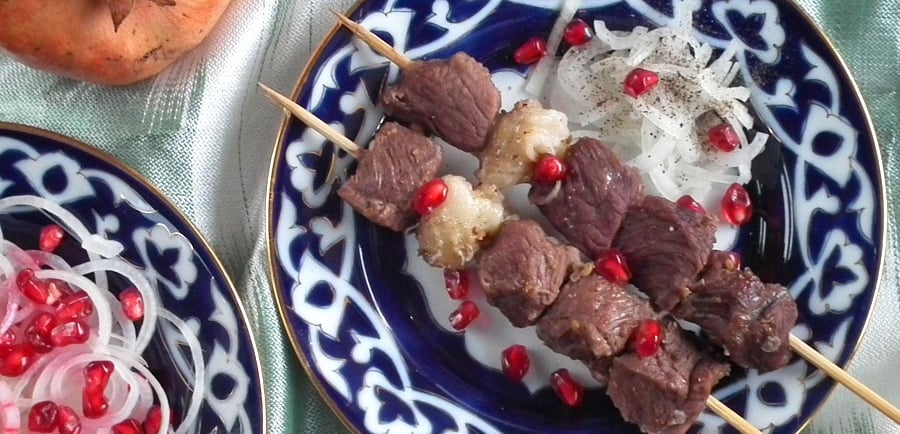Uzbek Food
Experience the rich taste of Uzbekistan, known for its hearty meat dishes, fresh vegetables, artisan bread, soups, dumplings, and sweet treats. With Uzbek Gourmet London, you can enjoy authentic delicacies like Plov, Pelmeni, Sumalak, Qurt, and more — all delivered fresh to your door. Taste the tradition and warmth of Uzbek cuisine at home. Order now for an unforgettable flavor experience!
12/20/20247 мин чтение


Uzbek cuisine is celebrated as one of the most flavourful in the world. Over centuries, it has absorbed and adapted culinary influences from neighbouring cultures, resulting in a rich and satisfying gastronomic experience. Unlike many of its Central Asian neighbours, Uzbek cuisine isn't limited to meat dishes. It also places great emphasis on fresh vegetables and salads, with the country's fruits and vegetables being so exceptional that they are exported worldwide.
Historically, however, the local diet was far simpler. Before the 19th century, meals primarily consisted of meat, dough, milk, and cereals. Today, beef and lamb remain staples of Uzbek cooking, with horse meat considered a delicacy. Poultry is less common, and fish dishes are rare due to the country's double-landlocked geography. The cuisine is distinguished by its generous use of seasonings, which enhance the natural flavours of each dish and leave a lasting, delicious aftertaste.
Hospitality is at the heart of Uzbek culture, and this is clearly reflected in its food traditions. Guests are never allowed to leave hungry. Accepting an invitation to dine at an Uzbek home means being treated to a table overflowing with dishes. Even after a hearty meal, guests are often sent home with leftovers as a gesture of generosity and warmth. This spirit of hospitality is as essential to Uzbek cuisine as the rich flavours that define it.


Uzbek cuisine is a meat lover's paradise, offering a diverse range of flavorful, tender, and hearty dishes. From sizzling kebabs to aromatic pilaf, every bite tells a story of tradition and culinary mastery.
Shashlik: The King of Kebabs
Kebabs, known locally as shashlik, are a quintessential part of Uzbek cuisine. These skewered, juicy meat bites come in a variety of styles, including ground beef (lyulya), mutton, beef, chicken, liver, and even vegetable options. The art of making shashlik is no simple task. Each kebab is marinated using secret family recipes that are often passed down through generations. The result is tender, flavorful, and slightly fatty perfection.
Kazan Kabob: A Hearty Lamb Roast
Among Uzbekistan's most beloved roasted dishes is kazan kabob. This dish features lamb still on the bone, fried in a large pot with onions, potatoes, and fragrant herbs. The result is a crispy, golden-brown exterior and a juicy, flavorful interior that leaves a lasting impression.
Dimlama, Kovurdok & More: Vegetable-Packed Roasts
For those seeking a mix of meat and vegetables, dimlama is the perfect choice. It’s a layered roast of meat, fresh vegetables, and herbs, slowly steamed to bring out a rich, harmonious flavor. Another hearty option is kovurdok (or kavurdak), a simple but satisfying roast made with onions, potatoes, and a light gravy. These dishes highlight the Uzbek love for slow-cooked, flavor-infused meals.
Unique Creations: Tukhum Dulma, Basma, and Narhangi
Uzbek cuisine also features more unique creations. Tukhum dulma is a fried cutlet made with boiled eggs at its center. Basma is a rich medley of vegetables and meat (typically lamb) stewed in its own natural juices, creating a melt-in-your-mouth dish. Similar in style is narhangi, which is prepared from minced lamb and vegetables, following a cooking process akin to domlama and basma.
The Legendary Plov: A National Treasure
No conversation about Uzbek cuisine is complete without mentioning plov (pilaf), the crown jewel of Uzbekistan’s culinary heritage. Traditionally prepared by men, there is even a special title for master pilaf chefs – oshpaz. Cooking plov is an event in itself, often made in large quantities to serve crowds rather than small groups. The dish combines meat, rice, carrots, onions, and a mix of fragrant spices, with each region adding its own unique twist. Plov is a source of pride for Uzbeks, and its preparation is considered an art form.
Shavla, Dolma, Hasip, and Kazy
For a simpler alternative to plov, there’s shavla, which uses similar ingredients but is easier to prepare. Dolma features grape or cabbage leaves stuffed with flavorful fillings, while hasip is a type of boiled sausage made from minced meat and rice. Another specialty is kazy, a sausage made from horse meat — a delicacy that reflects the nomadic roots of Central Asian cuisine.
From the sizzling aroma of shashlik to the rich taste of plov, Uzbek meat dishes embody the heart and soul of the country's culinary traditions. With each bite, you experience the warmth, hospitality, and rich flavors that define Uzbekistan’s food culture.


The History and Varieties of Uzbek Plov
A Dish with Deep Roots
Uzbek plov (also known as pilaf) is more than just a meal — it’s a symbol of tradition, hospitality, and community. Its history dates back thousands of years, with roots in the kitchens of ancient Persia, Central Asia, and the Middle East. Over time, Uzbekistan embraced and perfected this dish, turning it into a culinary masterpiece that has become an essential part of its national identity.
Legend has it that plov was first developed as a practical meal for soldiers and travellers. The combination of rice, meat, and vegetables created a nutritious, energy-packed dish that could be cooked in large quantities. Over centuries, it evolved into a dish of celebration, served at weddings, family gatherings, and major life events. Today, it’s a symbol of abundance and generosity, often prepared in massive quantities to feed large crowds.
One of the most fascinating aspects of Uzbek plov is the tradition surrounding its preparation. In Uzbekistan, the task of cooking plov is often reserved for men, particularly those who have earned the title of oshpaz — a master chef skilled in the art of making plov. Cooking this dish is seen as a mark of culinary excellence, and the process requires patience, precision, and knowledge of the ideal balance of ingredients and techniques.
Key Ingredients and Cooking Process
While the core ingredients of Uzbek plov remain consistent — rice, meat (usually lamb or beef), carrots, onions, and a blend of spices — the cooking process requires skill and careful attention. Traditionally, plov is cooked in a large cast-iron pot called a kazan. The meat is fried first, followed by onions and carrots, which are cooked until golden and aromatic. Spices like cumin, coriander, barberries, and black pepper are added to infuse the dish with rich, earthy flavours.
Once the vegetables and meat are ready, water is added, and the mixture simmers to create a flavourful broth. The rice is then layered on top, and it’s crucial that it’s not stirred. The rice absorbs the broth, allowing it to cook to perfection while remaining separate and fluffy. The final step is to allow the dish to steam, ensuring every grain of rice is infused with flavour.
Every region in Uzbekistan has its own unique approach to cooking plov, often adding special local ingredients or using distinct methods to prepare it. This diversity is one of the reasons why plov remains such a beloved and celebrated dish across the country.
Types of Uzbek Plov
The beauty of Uzbek plov lies in its regional variations, each offering a unique twist on the classic recipe. Here are some of the most well-known types of plov found throughout Uzbekistan:
Tashkent Plov This is the most famous and widely recognised version of plov. It’s made with yellow or orange carrots, beef or lamb, onions, garlic, and a mix of cumin and barberries. Tashkent plov is often garnished with quail eggs, chickpeas, and raisins for a touch of sweetness and colour.
Samarkand Plov Samarkand’s version of plov stands out due to its layered cooking technique. Unlike the Tashkent style, the ingredients are cooked in separate layers, and the rice remains white rather than golden. This method gives the dish a more subtle flavour, allowing each component to shine on its own. Chickpeas and raisins are often used to add texture and sweetness.
Bukhara Plov Bukhara plov is known for its sweet undertones, as it often includes dried fruits like apricots, raisins, or even pomegranate seeds. The rice is cooked with these fruits, creating a delicious balance of sweet and savoury flavours. This version is especially popular at weddings and celebratory feasts.
Khorezm Plov Hailing from the Khorezm region, this version of plov uses larger chunks of meat, often on the bone, for extra flavour. The carrots are cut into thicker strips, and the dish is usually heartier and more rustic. The cooking method differs slightly as well, with more emphasis on steaming to achieve a softer texture.
Ferghana Plov Ferghana plov is known for its rich, bold flavour and darker colour. This variety often uses beef or lamb and is distinguished by its darker, richer caramelised carrots and onions. The dish has a deeper, more robust taste, making it one of the most flavourful versions of plov in Uzbekistan.
Wedding Plov (Toy Osh) As the name suggests, this special plov is prepared for large wedding celebrations. It’s typically cooked in enormous kazan pots to serve hundreds of guests. Toy Osh is a symbol of hospitality and abundance, with generous portions of meat, carrots, and rice. Quail eggs, chickpeas, raisins, and garlic bulbs are often used as decorative garnishes to enhance both the flavour and appearance.
Cultural Significance of Plov
Plov holds a special place in Uzbek culture, far beyond its taste. It’s seen as a dish of unity and celebration, playing a central role in weddings, holidays, and major life events. Cooking plov is also a communal experience, with friends and family gathering to assist or watch the process. It’s a dish that brings people together, symbolising warmth, generosity, and shared joy.
Beyond its role in social events, plov is also served during times of reflection and remembrance. It’s common for communities to prepare and share plov during memorial gatherings to honour loved ones who have passed away.
A Culinary Icon
Uzbek plov is more than just food — it’s a cultural icon that embodies the spirit of Uzbekistan. With its rich history, diverse regional variations, and symbolic significance, plov remains one of the most beloved dishes in Central Asia. Each bite offers a taste of history, hospitality, and tradition, and for those fortunate enough to experience it, plov is a meal that leaves a lasting impression.
